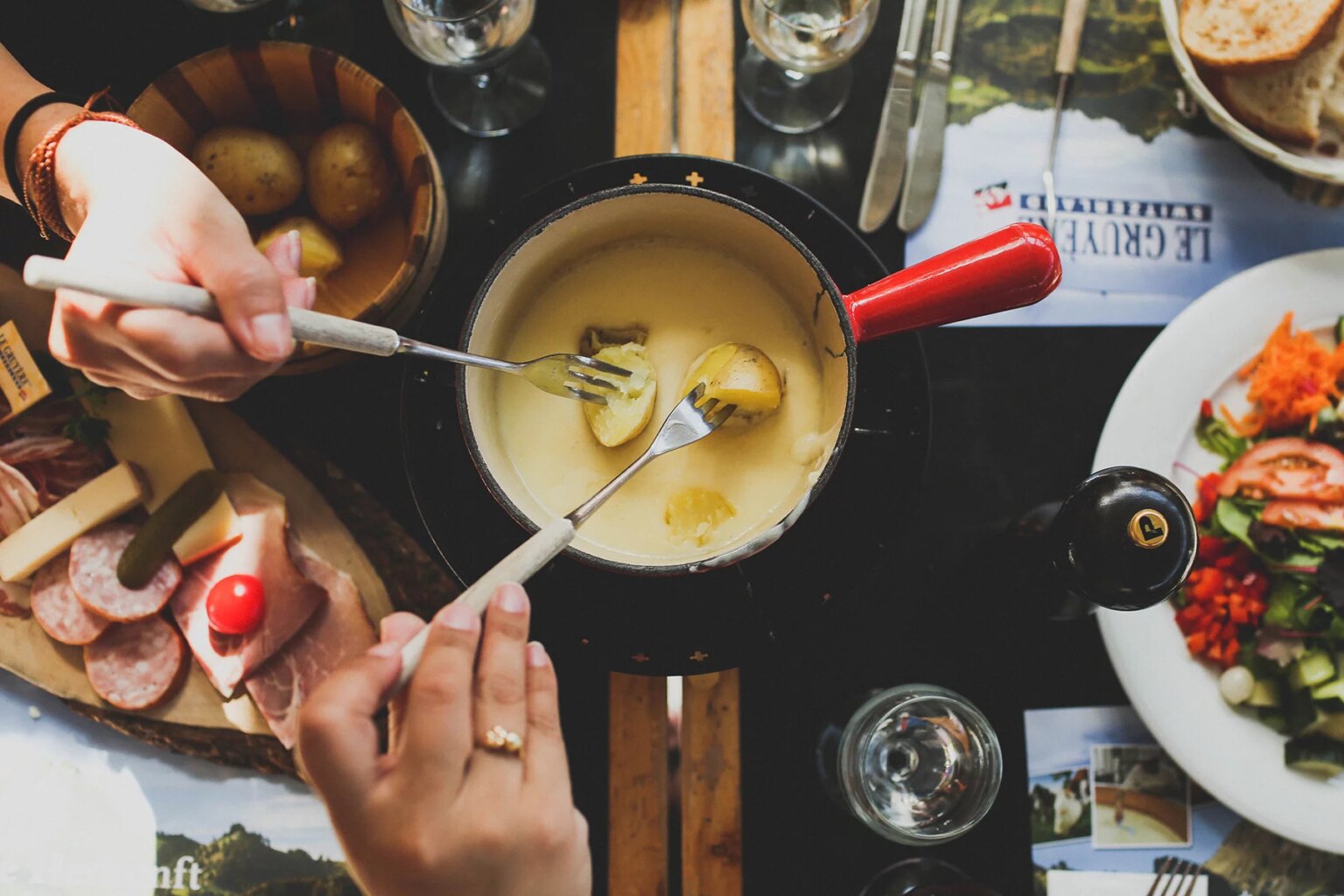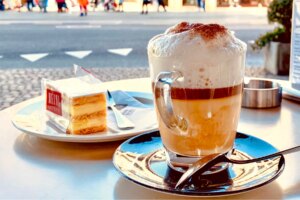Cheese is one of Switzerland’s primary exports and is central to both the national identity and its cuisine. Fondue presents a delicious combination of the finest Swiss cheese, wine, and communal atmosphere. It can be enjoyed in an alpine restaurant, during aprés-ski, or in the comfort of home. It is hard to resist a steaming bowl of melted cheese shared with family and friends.
The Swiss love to say la fondue crée la bonne humeur or Fondue isch guet und git e gueti Luune; that means fondue is good and creates a good mood. Who can argue with that?
This primer to Swiss fondue covers everything you need to know, including topics such as:
HelloFresh
Need a night off from eating fondue? HelloFresh can help. They provide fresh and innovative recipe boxes direct to your front door. Choose from a wide range of colorful meals from Switzerland and beyond that are perfect for taking your meals to the next level. Get more from mealtime with HelloFresh
The history of Swiss fondue
While the Swiss have certainly made fondue famous around the world, its exact origins can be difficult to pin down. There was already mention of cooking goat’s cheese, wine, and flour together from Homer’s epic the Iliad around 800 to 725 BC. The word ‘fondue’ comes from the French verb fondre (to melt), and has roots in the Swiss cantons of Fribourg and Valais. The first mention of fondue in printed form comes from a 1699 book published under the name Käss mit Wein zu kochen (to cook cheese with wine). Until the mid 19th century, the popular style of fondue more closely resembled a combination of scrambled eggs and cheese soufflé. It was only in the latter part of the 19th century that the modern form of Swiss fondue took hold.

The popular legend is that peasants, braving the winter months in the Swiss Alps, found that melting cheese and wine together made for a delicious way to stay warm and use up stale bread. However, the prices of fine cheese and wine made fondue more often a staple for wealthier urban Swiss families. The Swiss Cheese Union declared fondue the country’s national dish in an effort to boost both exports and domestic cheese sales during the interwar period. Fondue featured heavily at the Swiss pavilion at the 1964 World’s Fair in New York, ushering in a period where fondue restaurants, serving sets, and parties became commonplace throughout North America and Europe. Ad campaigns featured attractive young people, fresh from the slopes, drinking and laughing while huddled around a fondue. It was a communal dish that matched the swinging spirit of the 1960s and 1970s and has maintained its popularity today.
When and where to eat Swiss fondue
While fondue can be eaten year-round on the French side of Switzerland, the rest of the country reserves the dish for the fall and winter months. Fondue is primarily served as the main dish, not an appetizer or as part of a multicourse meal. A fondue meal is quite filling. It is best to avoid having one for lunch if you plan on being rather active in the afternoon.
Fondue is available in family-run restaurants in alpine villages to long-standing establishments in Geneva, Zurich, or Lausanne. It is as ubiquitous in Switzerland as cowbells and chocolate. Many restaurants, offering varying levels of quality, will cater to the tourist crowd. It is worth checking out online reviews or asking Swiss friends or colleagues where their favorite spots are, as everyone is bound to have a strong opinion. Many Swiss will tell you with pride that the best place to eat fondue is at home.
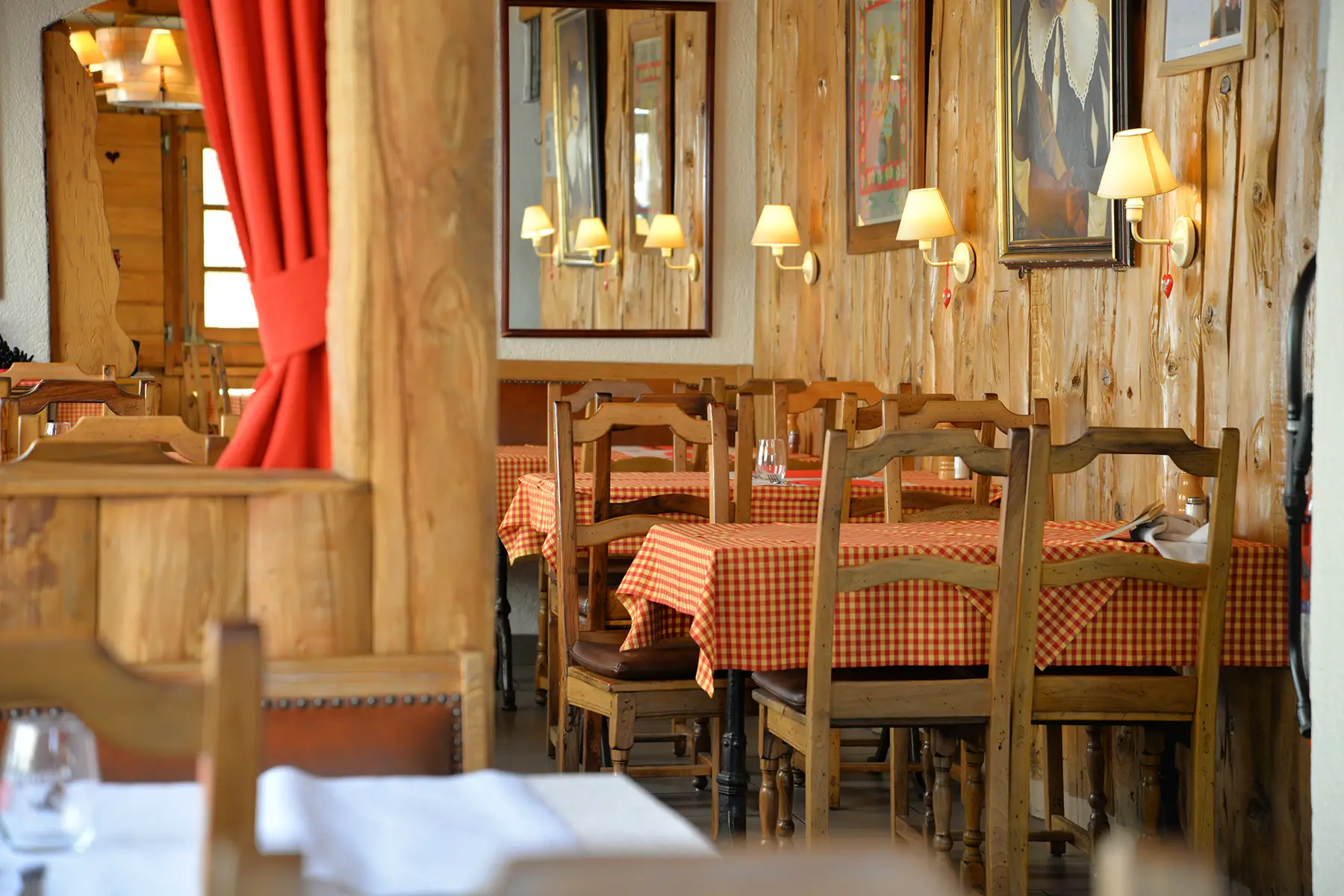
Some of the top places to get fondue in Switzerland include:
- La Buvette des Bains (Geneva)
- Café du Soleil (Geneva)
- Le Chalet (Gruyères)
- Chäsalp (Zurich)
- Fribourger Fonduestübli (Zurich)
- Ganni (Vals)
- Restaurant Zugerberg (Zug)
Swiss fondue etiquette
The Swiss can be rather particular when it comes to how fondue should be served and eaten. Whether you are out in public, or in the comfort of home, it is important to follow some fondue etiquette.
Make sure you use the right tools and materials for dipping
Bread is the main accompaniment, although boiled potatoes, charcuterie, and cornichons or other pickles can also be served. Veggies, fruit, and boiled eggs are not traditionally used in Swiss fondue. Take a piece of bread and spear it firmly on your fondue fork so that the crust is on the outside. Pull the bread off the fork with your teeth while trying not to touch the fork itself with your mouth. You can even use a regular knife and fork to pull the bread onto your plate if you want to be extra cautious. Be careful with your bread and don’t make the mistake of dropping your bread into the fondue pot. You may have to buy a round of drinks, sing a song, or kiss other guests around the table!
Watch how you stir your bread
It is customary to stir in a clockwise or figure-eight motion to keep the cheese mixed properly. Do not dip your bread in the pot while someone else is already swirling. When you pull your bread out of the cheese, twirl it at least three times to allow all the excess to fall back in the pot. Do not tap or scrape your bread on the side of the pot. Absolutely refrain from double-dipping!
Maintain the right heat and consistency
Fondue should be kept warm enough to keep the cheese at a smooth consistency, but not hot enough that it burns. If you maintain the right temperature and stir the mixture regularly, you will be rewarded with a thin crust of toasted cheese at the bottom of the pot. This is the Grossmutter in German, or La Religieuse (the nun) in French; it’s the most savory part of the fondue. Cut this piece out and make sure to share it between those at the table.
Make sure you choose the right beverage
Traditionalists insist that only dry and acidic white wine, kirsch, or warm herbal tea should be consumed as they supposedly aid in digestion. Beer, carbonated drinks, and cold water are definitely to be avoided as they are seen to have the opposite effect. While science may not support this belief, failure to comply will likely attract disapproving looks from your Swiss counterparts.
Select the appropriate dessert
Cheese fondue should never be followed with chocolate fondue. This may seem like a naturally delicious progression but it is never suggested in Switzerland who would never want to have too much of a good thing. Instead, it is customary to eat acidic fruits, like fresh pineapple, to help you easily digest all that creamy cheese.
What you need to make great Swiss fondue
The first thing you need is a proper fondue pot (or caquelon in french) that can be served over a controllable flame. Each diner should have their own fondue fork and plate to handle the items they will dip into the cheese. Swiss weizenbrot is common, but any good baguette with a hearty crust will suffice.
Gruyère and Fribourg vacherin are the most traditional cheeses for fondue, although Emmental and Appenzeller or are also common. French Beaufort and Comté can also be used for the signature Swiss fondue flavor. Sometimes the Swiss will use spreadable cheeses like Laughing Cow as it helps with the consistency, but this is something that fondue purists scoff at.
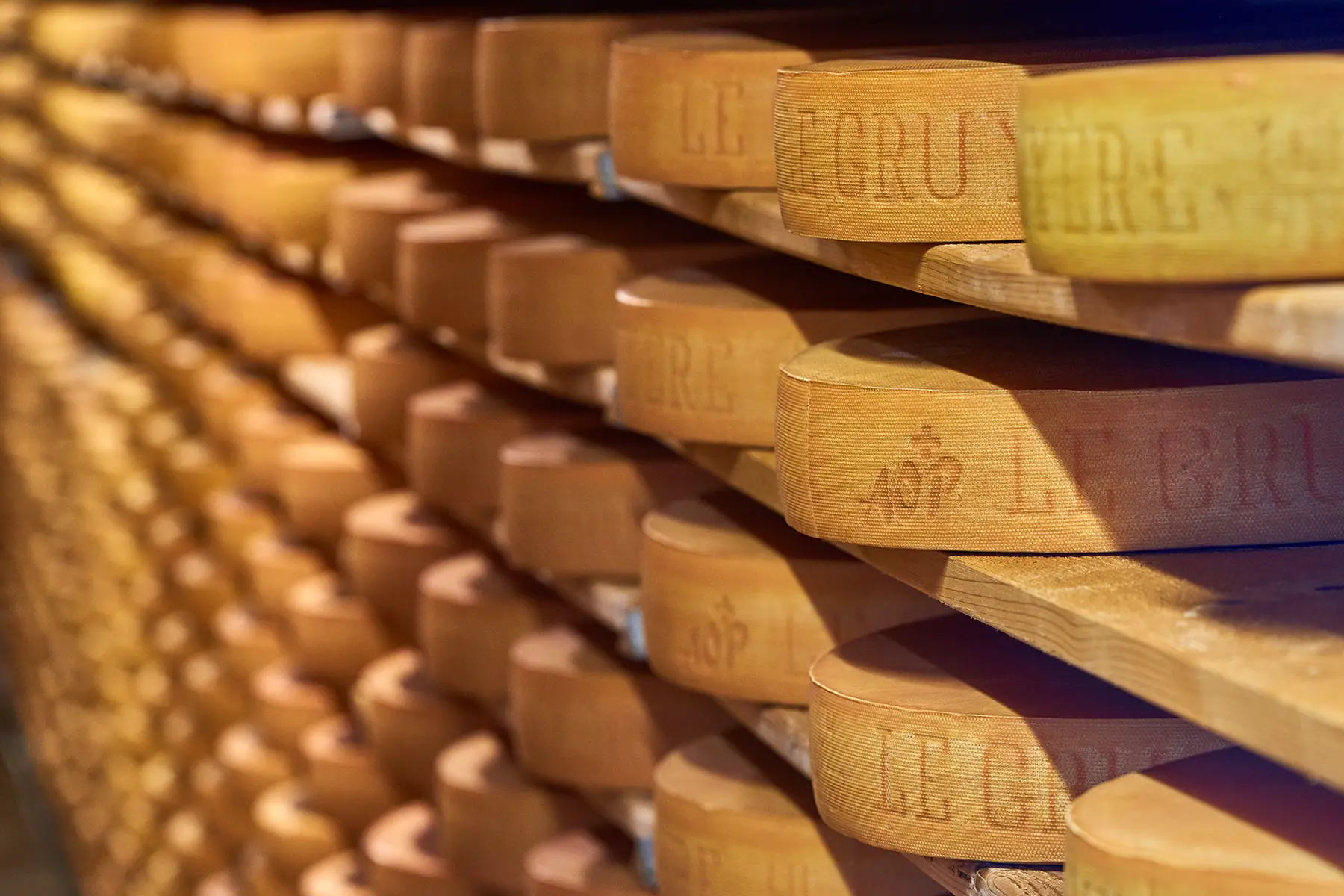
Traditionally, the fondue pot is first rubbed with one or two cut garlic cloves. Dry acidic white wine is then added and heated with corn starch. The grated cheese is then added and gently stirred until melted. A Chasselas Romand (or Fendant), Chignin, or Roussette are all good Swiss wines to use as they ensure good flavor and consistency. If you cannot get hold of such wine, a Muscadet or a Sauvignon Blanc will also do, perhaps with a slight squeeze of lemon juice. Some kirsch (or cherry brandy) often goes in next, along with nutmeg. You can serve your guests le coup du milieu, which is a shot of kirsch halfway through the fondue to both aid digestion and stimulate any faltering appetites.
Looking for a practically effortless, spur-of-the-moment fondue on a Tuesday night? Many Swiss supermarkets sell a surprising array of quality pre-made vacuum-packed versions that you can whip up in minutes.
Variations of Swiss fondue
There are many variations to the traditional swiss fondue which include tomatoes, mushrooms, paprika, chilis, or bacon. The French alpine variation uses cheese traditionally from the Haute-Savoie region such as Comté, Beaufort, Reblochon and Abondance. The Italian alpine variation (Fonduta alla valdostana), typical to the Aosta Valley, has a unique mixture of Fontina, milk, and eggs.
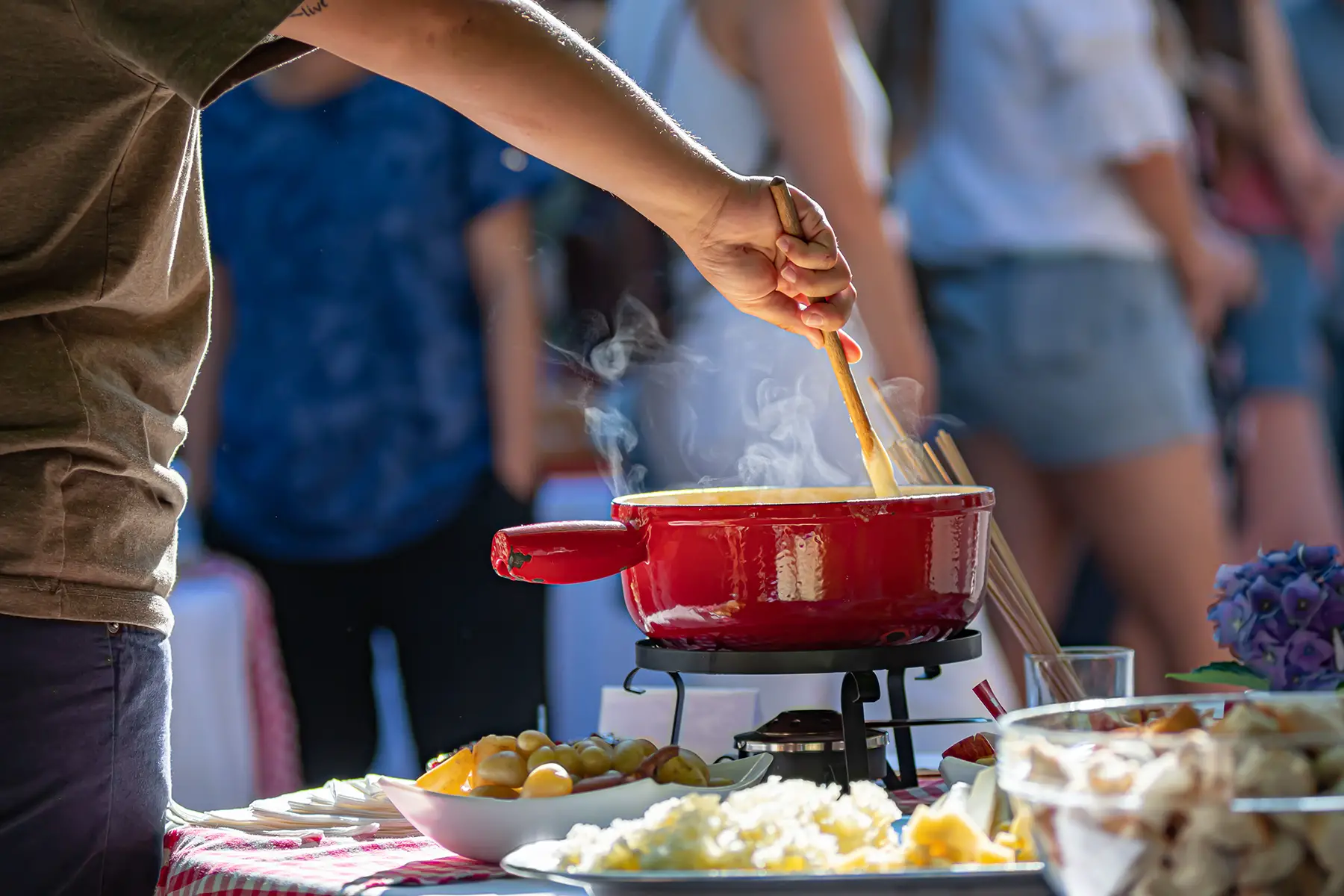
Fondue bourguignonne is a variation where diners dip meat and vegetables into a pot of hot oil to cook them. A variety of dipping sauces, such as Béarnaise or mustard, are available for additional flavor. Fondue Bacchus is similar but uses wine instead of oil. Red wine mixes are often seasoned with pepper, garlic, and onions, while white wine versions contain cinnamon, coriander, white pepper, and chicken broth.
Dessert variations of fondue often consist of melted chocolate mixed with rum, coconut, or caramel. Diners dip slices of white cake or fruits such as strawberries, oranges, grapes, and bananas in the sweet concoction.
Useful resources
- Basics with Babish – easy video tutorial on making Swiss, French, and Italian cheese fondue
- How to make the perfect fondue – a recipe and instructions from The Guardian
